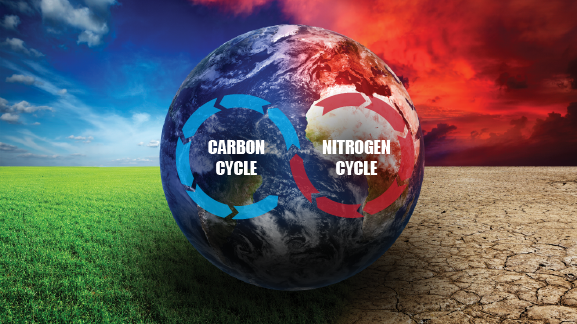Carbon and nitrogen cycles interact with vegetation shifts

Carbon cycle feedback: When it comes to understanding the forests' role in both giving off and capturing carbon dioxide, those are three words that contain a lot of science. In a new study, researchers led by Pacific Northwest National Laboratory incorporated into an Earth system model the complex role of the ecosystem in amping or damping the concentration of carbon dioxide (CO2) in the atmosphere.
It's a process called dynamic vegetation—where plants can shift their habitats in response to environmental changes such as a hotter weather system or limited nutrients. Using a land-system model with dynamic vegetation enabled or disabled, the research team found that nitrogen and its interaction with plants has a strong influence on how plants respond to environmental changes. This influence can result in amplification or reduction of carbon dioxide, which is responsible for the environmental changes in the first place. The research showed how effective modeling of dynamic vegetation and the nitrogen cycle can increase understanding of carbon cycle and future climate changes.
The terrestrial ecosystem plays a large role in the Earth's carbon cycle by inhaling and exhaling CO2 from the atmosphere. A higher level of CO2 helps plants more efficiently use the sun's energy for photosynthesis, which causes them to remove (inhale) more CO2 from the atmosphere. On the other hand, a higher CO2 level in the atmosphere leads to higher temperatures, which can impose heat stress on plants and hasten the organic matter in surface plant litter and soil to decompose. Both the increased stress and the faster decomposition of organic material add more CO2 into the atmosphere than is removed by the increased photosynthesis. This net increase of CO2 exhalation by plants as atmospheric CO2 increases is a positive carbon cycle feedback that amplifies CO2 in the atmosphere.
But here's where nitrogen throws a wrench into the carbon cycle gears. Faster decomposition of organic carbon makes more nitrogen available to plants, helping them take in more CO2 as they grow, reducing the atmospheric levels. This is a negative carbon cycle feedback. However, the strength of this negative carbon cycle feedback is dependent on whether the vegetation type is allowed to shift with environmental changes because some plants require more nitrogen than others. This study demonstrated how the nitrogen cycle and dynamic vegetation and their interaction determine how plants across the globe can amplify or dampen the increase of atmospheric CO2 and associated climate warming.
Among the Earth system models that contributed to the Intergovernmental Panel on Climate Change (IPCC) fifth assessment report in 2013, only a handful included dynamic vegetation, and even fewer incorporated the nitrogen cycle. Evidence is growing that these two processes will play a key role in the future carbon cycle.
Scientists at Pacific Northwest National Laboratory and their collaborators studied one of the few global land models, the Community Land Model version 4, that is able to simulate vegetation cover change responding to both the evolving climate and nitrogen cycle. By running a series of simulations for different climate and CO2 change scenarios, they were able to calculate the sensitivity of terrestrial carbon to climate warming and CO2 increase. Land carbon sensitivity is an important factor that constitutes the feedback to CO2 increase. The effect of vegetation change on this factor has rarely been studied. The team repeated the same set of experiments without a dynamic vegetation model.
Their analysis showed a significant difference in the potential strength of the carbon cycle feedback with and without the dynamic vegetation cover that responds to the climate state. The team also found a link between the emerging characteristics of plant nitrogen demand from inadequate representation of plant competition in the dynamic vegetation model over the tropics and subtropics. The analysis also found that errors in simulating vegetation cover can propagate to broader scales through interaction with the nitrogen cycle. The research illustrated a specific example of such error propagation to guide model development efforts.
With the relevant vegetation processes improved in the next generation Earth system models, representation of the carbon cycle feedback can be better characterized. Future studies will perform simulations with the global land model coupled to atmosphere, ocean, and other Earth system component models to quantify carbon-climate interactions, with a particular focus on the tropical forest setting.
More information: K Sakaguchi et al. Influence of dynamic vegetation on carbon-nitrogen cycle feedback in the Community Land Model (CLM4), Environmental Research Letters (2016). DOI: 10.1088/1748-9326/aa51d9
Journal information: Environmental Research Letters
Provided by Pacific Northwest National Laboratory



















